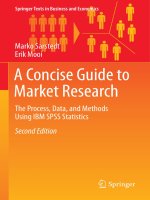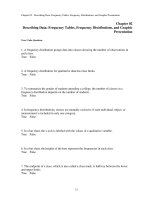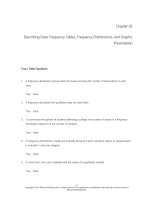Time series econometrics (springer texts in business and economics)
Bạn đang xem bản rút gọn của tài liệu. Xem và tải ngay bản đầy đủ của tài liệu tại đây (19.82 MB, 408 trang )
Springer Texts in Business and Economics
More information about this series at http://www.springer.com/series/10099
Klaus Neusser
Time Series Econometrics
Klaus Neusser
Bern, Switzerland
ISSN 2192-4333
e-ISSN 2192-4341
ISBN 978-3-319-32861-4 e-ISBN 978-3-319-32862-1
DOI 10.1007/978-3-319-32862-1
Library of Congress Control Number: 2016938514
© Springer International Publishing Switzerland 2016
Springer Texts in Business and Economics
This Springer imprint is published by Springer Nature
This work is subject to copyright. All rights are reserved by the Publisher, whether the whole or part
of the material is concerned, specifically the rights of translation, reprinting, reuse of illustrations,
recitation, broadcasting, reproduction on microfilms or in any other physical way, and transmission
or information storage and retrieval, electronic adaptation, computer software, or by similar or
dissimilar methodology now known or hereafter developed.
The use of general descriptive names, registered names, trademarks, service marks, etc. in this
publication does not imply, even in the absence of a specific statement, that such names are exempt
from the relevant protective laws and regulations and therefore free for general use.
The publisher, the authors and the editors are safe to assume that the advice and information in this
book are believed to be true and accurate at the date of publication. Neither the publisher nor the
authors or the editors give a warranty, express or implied, with respect to the material contained
herein or for any errors or omissions that may have been made.
Printed on acid-free paper
The registered company is Springer International Publishing AG Switzerland
Preface
Over the past decades, time series analysis has experienced a proliferous increase of applications in
economics, especially in macroeconomics and finance. Today these tools have become indispensable
to any empirically working economist. Whereas in the beginning the transfer of knowledge essentially
flowed from the natural sciences, especially statistics and engineering, to economics, over the years
theoretical and applied techniques specifically designed for the nature of economic time series and
models have been developed. Thereby, the estimation and identification of structural vector
autoregressive models, the analysis of integrated and cointegrated time series, and models of
volatility have been extremely fruitful and far-reaching areas of research. With the award of the
Nobel Prizes to Clive W. J. Granger and Robert F. Engle III in 2003 and to Thomas J. Sargent and
Christopher A. Sims in 2011, the field has reached a certain degree of maturity. Thus, the idea
suggests itself to assemble the vast amount of material scattered over many papers into a
comprehensive textbook.
The book is self-contained and addresses economics students who have already some
prerequisite knowledge in econometrics. It is thus suited for advanced bachelor, master’s, or
beginning PhD students but also for applied researchers. The book tries to bring them in a position to
be able to follow the rapidly growing research literature and to implement these techniques on their
own. Although the book is trying to be rigorous in terms of concepts, definitions, and statements of
theorems, not all proofs are carried out. This is especially true for the more technically and lengthy
proofs for which the reader is referred to the pertinent literature.
The book covers approximately a two-semester course in time series analysis and is divided in
two parts. The first part treats univariate time series, in particular autoregressive moving-average
processes. Most of the topics are standard and can form the basis for a one-semester introductory
time series course. This part also contains a chapter on integrated processes and on models of
volatility. The latter topics could be included in a more advanced course. The second part is devoted
to multivariate time series analysis and in particular to vector autoregressive processes. It can be
taught independently of the first part. The identification, modeling, and estimation of these processes
form the core of the second part. A special chapter treats the estimation, testing, and interpretation of
cointegrated systems. The book also contains a chapter with an introduction to state space models and
the Kalman filter. Whereas the books is almost exclusively concerned with linear systems, the last
chapter gives a perspective on some more recent developments in the context of nonlinear models. I
have included exercises and worked out examples to deepen the teaching and learning content.
Finally, I have produced five appendices which summarize important topics such as complex
numbers, linear difference equations, and stochastic convergence.
As time series analysis has become a tremendously growing field with an active research in many
directions, it goes without saying that not all topics received the attention they deserved and that there
are areas not covered at all. This is especially true for the recent advances made in nonlinear time
series analysis and in the application of Bayesian techniques. These two topics alone would justify an
extra book.
The data manipulations and computations have been performed using the software packages
EVIEWS and MATLAB. 1 Of course, there are other excellent packages available. The data for the
examples and additional information can be downloaded from my home page www.neusser.ch. To
maximize the learning success, it is advised to replicate the examples and to perform similar
exercises with alternative data. Interesting macroeconomic time series can, for example, be
downloaded from the following home pages:
Germany: www.bundesbank.de
Switzerland: www.snb.ch
United Kingdom: www.statistics.gov.uk
United States: research.stlouisfed.org/fred2
The book grew out of lectures which I had the occasion to give over the years in Bern and other
universities. Thus, it is a concern to thank the many students, in particular Philip Letsch, who had to
work through the manuscript and who called my attention to obscurities and typos. I also want to
thank my colleagues and teaching assistants Andreas Bachmann, Gregor Bäurle, Fabrice Collard,
Sarah Fischer, Stephan Leist, Senada Nukic, Kurt Schmidheiny, Reto Tanner, and Martin Wagner for
reading the manuscript or part of it and for making many valuable criticisms and comments. Special
thanks go to my former colleague and coauthor Robert Kunst who meticulously read and commented
on the manuscript. It goes without saying that all errors and shortcomings go to my expense.
Klaus Neusser
Bern, Switzerland/Eggenburg, Austria
February 2016
Notation and Symbols
r
α
β
number of linearly independent cointegration vectors
n × r loading matrix
n × r matrix of linearly independent cointegration vectors
convergence in distribution
convergence in mean square
convergence in probability
corr(X,Y) correlation coefficient beween random variables X and Y
γ X , γ covariance function of process { X t }, covariance function
ρ X , ρ correlation function of process { X t }, correlation function
ACF autocorrelation function
J
long-run variance
α X , α partial autocorrelation function of process { X t }
PACF partial autocorrelation function
n dimension of stochastic process, respectively dimension of state space
∼ is distributed as
sgn sign function
tr trace of a matrix
det determinant of a matrix
∥ ∥ norm of a matrix
⊗ Kronecker product
⊙ Hadamard product
vec( A ) stakes the columns of A into a vector
vech( A ) stakes the lower triangular part of a symmetric matrix A into a vector
GL( n ) general linear group of n × n matrices
group of orthogonal n × n matrices
L lag operator
Φ (L) autoregressive polynomial
Θ (L) moving-average polynomial
Ψ (L) causal representation, MA( ∞ ) polynomial
Δ difference operator, Δ = 1 − L
p order of autoregressive polynomial
q order of moving-average polynomial
ARMA(p,q) autoregressive moving-average process of order ( p , q )
ARIMA(p,d,q) autoregressive integrated moving-average process of order ( p , d , q )
d order of integration
I(d) integrated process of order d
VAR(p) vector autoregressive process of order p
integer numbers
real numbers
complex numbers
set of n-dimensional vectors
imaginary unit
cov(X,Y) covariance beween random variables X and Y
expectation operator
variance operator
Ψ (1) persistence
linear least-squares predictor of X T + h given information from period 1 up to period T
linear least-squares predictor of X T + h using the infinite remote past up to period T
P Probability
{ X t } stochastic process
WN(0, σ 2 ) white noise process with mean zero and variance σ 2
WN(0, Σ ) multivariate white noise process with mean zero and covariance matrix Σ 2
IID(0, σ 2 ) identically and independently distributed random variables with mean zero and
variance σ 2
IID N(0, σ 2 ) identically and independently normally distributed random variables with mean
zero and variance σ 2
X t time indexed random variable
x t realization of random variable X t
f ( λ ) spectral density
F ( λ ) spectral distribution function
I T periodogram
transfer function of filter Ψ
VaR value at risk
Contents
Part I Univariate Time Series Analysis
1 Introduction
1.1 Some Examples
1.2 Formal Definitions
1.3 Stationarity
1.4 Construction of Stochastic Processes
1.4.1 White Noise
1.4.2 Construction of Stochastic Processes: Some Examples
1.4.3 Moving-Average Process of Order One
1.4.4 RandomWalk
1.4.5 Changing Mean
1.5 Properties of the Autocovariance Function
1.5.1 Autocovariance Function of MA(1) Processes
1.6 Exercises
2 ARMA Models
2.1 The Lag Operator
2.2 Some Important Special Cases
2.2.1 Moving-Average Process of Order q
2.2.2 First Order Autoregressive Process
2.3 Causality and Invertibility
2.4 Computation of Autocovariance Function
2.4.1 First Procedure
2.4.2 Second Procedure
2.4.3 Third Procedure
2.5 Exercises
3 Forecasting Stationary Processes
3.1 Linear Least-Squares Forecasts
3.1.1 Forecasting with an AR(p) Process
3.1.2 Forecasting with MA(q) Processes
3.1.3 Forecasting from the Infinite Past
3.2 The Wold Decomposition Theorem
3.3 Exponential Smoothing
3.4 Exercises
3.5 Partial Autocorrelation
3.5.1 Definition
3.5.2 Interpretation of ACF and PACF
3.6 Exercises
4 Estimation of Mean and ACF
4.1 Estimation of the Mean
4.2 Estimation of ACF
4.3 Estimation of PACF
4.4 Estimation of the Long-Run Variance
4.4.1 An Example
4.5 Exercises
5 Estimation of ARMA Models
5.1 The Yule-Walker Estimator
5.2 OLS Estimation of an AR(p) Model
5.3 Estimation of an ARMA(p,q) Model
5.4 Estimation of the Orders p and q
5.5 Modeling a Stochastic Process
5.6 Modeling Real GDP of Switzerland
6 Spectral Analysis and Linear Filters
6.1 Spectral Density
6.2 Spectral Decomposition of a Time Series
6.3 The Periodogram and the Estimation of Spectral Densities
6.3.1 Non-Parametric Estimation
6.3.2 Parametric Estimation
6.4 Linear Time-Invariant Filters
6.5 Some Important Filters
6.5.1 Construction of Low- and High-Pass Filters
6.5.2 The Hodrick-Prescott Filter
6.5.3 Seasonal Filters
6.5.4 Using Filtered Data
6.6 Exercises
7 Integrated Processes
7.1 Definition, Properties and Interpretation
7.1.1 Long-Run Forecast
7.1.2 Variance of Forecast Error
7.1.3 Impulse Response Function
7.1.4 The Beveridge-Nelson Decomposition
7.2 Properties of the OLS Estimator in the Case of Integrated Variables
7.3 Unit-Root Tests
7.3.1 Dickey-Fuller Test
7.3.2 Phillips-Perron Test
7.3.3 Unit-Root Test: Testing Strategy
7.3.4 Examples of Unit-Root Tests
7.4 Generalizations of Unit-Root Tests
7.4.1 Structural Breaks in the Trend Function
7.4.2 Testing for Stationarity
7.5 Regression with Integrated Variables
7.5.1 The Spurious Regression Problem
7.5.2 Bivariate Cointegration
7.5.3 Rules to Deal with Integrated Times Series
8 Models of Volatility
8.1 Specification and Interpretation
8.1.1 Forecasting Properties of AR(1)-Models
8.1.2 The ARCH(1) Model
8.1.3 General Models of Volatility
8.1.4 The GARCH(1,1) Model
8.2 Tests for Heteroskedasticity
8.2.1 Autocorrelation of Quadratic Residuals
8.2.2 Engle’s Lagrange-Multiplier Test
8.3 Estimation of GARCH(p,q) Models
8.3.1 Maximum-Likelihood Estimation
8.3.2 Method of Moment Estimation
8.4 Example: Swiss Market Index (SMI)
Part II Multivariate Time Series Analysis
9 Introduction
10 Definitions and Stationarity
11 Estimation of Covariance Function
11.1 Estimators and Asymptotic Distributions
11.2 Testing Cross-Correlations of Time Series
11.3 Some Examples for Independence Tests
12 VARMA Processes
12.1 The VAR(1) Process
12.2 Representation in Companion Form
12.3 Causal Representation
12.4 Computation of Covariance Function
13 Estimation of VAR Models
13.1 Introduction
13.2 The Least-Squares Estimator
13.3 Proofs of Asymptotic Normality
13.4 The Yule-Walker Estimator
14 Forecasting with VAR Models
14.1 Forecasting with Known Parameters
14.1.1 Wold Decomposition Theorem
14.2 Forecasting with Estimated Parameters
14.3 Modeling of VAR Models
14.4 Example: VAR Model
15 Interpretation of VAR Models
15.1 Wiener-Granger Causality
15.1.1 VAR Approach
15.1.2 Wiener-Granger Causality and Causal Representation
15.1.3 Cross-Correlation Approach
15.2 Structural and Reduced Form
15.2.1 A Prototypical Example
15.2.2 Identification: The General Case
15.2.3 Identification: The Case n = 2
15.3 Identification via Short-Run Restrictions
15.4 Interpretation of VAR Models
15.4.1 Impulse Response Functions
15.4.2 Variance Decomposition
15.4.3 Confidence Intervals
15.4.4 Example 1: Advertisement and Sales
15.4.5 Example 2: IS-LM Model with Phillips Curve
15.5 Identification via Long-Run Restrictions
15.5.1 A Prototypical Example
15.5.2 The General Approach
15.6 Sign Restrictions
16 Cointegration
16.1 A Theoretical Example
16.2 Definition and Representation
16.2.1 Definition
16.2.2 VAR and VEC Models
16.2.3 Beveridge-Nelson Decomposition
16.2.4 Common Trend Representation
16.3 Johansen’s Cointegration Test
16.3.1 Specification of the Deterministic Components
16.3.2 Testing Cointegration Hypotheses
16.4 Estimation and Testing of Cointegrating Relationships
16.5 An Example
17 Kalman Filter
17.1 The State Space Model
17.1.1 Examples
17.2 Filtering and Smoothing
17.2.1 The Kalman Filter
17.2.2 The Kalman Smoother
17.3 Estimation of State Space Models
17.3.1 The Likelihood Function
17.3.2 Identification
17.4 Examples
17.4.1 Estimation of Quarterly GDP
17.4.2 Structural Time Series Analysis
17.5 Exercises
18 Generalizations of Linear Models
18.1 Structural Breaks
18.1.1 Methodology
18.1.2 An Example
18.2 Time-Varying Parameters
18.3 Regime Switching Models
A Complex Numbers
B Linear Difference Equations
C Stochastic Convergence
D BN-Decomposition
E The Delta Method
Bibliography
Index
List of Figures
Fig. 1.1 Real gross domestic product (GDP)
Fig. 1.2 Growth rate of real gross domestic product (GDP)
Fig. 1.3 Swiss real gross domestic product
Fig. 1.4 Short- and long-term Swiss interest rates
Fig. 1.5 Swiss Market Index (SMI). ( a ) Index. ( b ) Daily return
Fig. 1.6 Unemployment rate in Switzerland
Fig. 1.7 Realization of a random walk
Fig. 1.8 Realization of a branching process
Fig. 1.9 Processes constructed from a given white noise process. ( a ) White noise. ( b ) Movingaverage with θ = 0. 9. ( c ) Autoregressive with ϕ = 0. 9. ( d ) Random walk
Fig. 1.10 Relation between the autocorrelation coefficient of order one, ρ (1), and the parameter θ of
a MA(1) process
Fig. 2.1 Realization and estimated ACF of MA(1) process
Fig. 2.2 Realization and estimated ACF of an AR(1) process
Fig. 2.3 Autocorrelation function of an ARMA(2,1) process
Fig. 3.1 Autocorrelation and partial autocorrelation functions. ( a ) Process 1. ( b ) Process 2. ( c )
Process 3. ( d ) Process 4
Fig. 4.1 Estimated autocorrelation function of a WN(0,1) process
Fig. 4.2 Estimated autocorrelation function of MA(1) process
Fig. 4.3 Estimated autocorrelation function of an AR(1) process
Fig. 4.4 Estimated PACF of an AR(1) process
Fig. 4.5 Estimated PACF for a MA(1) process
Fig. 4.6 Common kernel functions
Fig. 4.7 Estimated autocorrelation function for the growth rate of GDP
Fig. 5.1 Parameter space of causal and invertible ARMA(1,1) process
Fig. 5.2 Real GDP growth rates of Switzerland
Fig. 5.3 ACF and PACF of GDP growth rate
Fig. 5.4 Inverted roots of the ARMA(1,3) model
Fig. 5.5 ACF of the residuals from AR(2) and ARMA(1,3) models
Fig. 5.6 Impulse responses of the AR(2) and the ARMA(1,3) model
Fig. 5.7 Forecasts of real GDP growth rates
Fig. 6.1 Examples of spectral densities with Z t ∼ WN(0, 1). ( a ) MA(1) process. ( b ) AR(1)
process
Fig. 6.2 Raw periodogram of a white noise time series ( X t ∼ WN(0, 1), T = 200)
Fig. 6.3 Raw periodogram of an AR(2) process ( X t = 0. 9 X t −1 − 0. 7 X t −2 + Z t with Z t ∼ WN(0,
1), T = 200)
Fig. 6.4 Non-parametric direct estimates of a spectral density
Fig. 6.5 Nonparametric and parametric estimates of spectral density
Fig. 6.6 Transfer function of the Kuznets filters
Fig. 6.7 Transfer function of HP-filter
Fig. 6.8 HP-filtered US GDP
Fig. 6.9 Transfer function of growth rate of investment in the construction sector with and without
seasonal adjustment
Fig. 7.1 Distribution of the OLS estimator
Fig. 7.2 Distribution of t-statistic and standard normal distribution
Fig. 7.3 ACF of a random walk with 100 observations
Fig. 7.4 Three types of structural breaks at T B . ( a ) Level shift. ( b ) Change in slope. ( c ) Level
shift and change in slope
Fig. 7.5 Distribution of OLS-estimate
and t-statistic
independent AR(1) processes. ( a ) Distribution of
for two independent random walks and two
. ( b ) Distribution of
. ( c ) Distribution of
and t-statistic
Fig. 7.6 Cointegration of inflation and three-month LIBOR. ( a ) Inflation and three-month LIBOR. ( b
) Residuals from cointegrating regression
Fig. 8.1 Simulation of two ARCH(1) processes
Fig. 8.2 Parameter region for which a strictly stationary solution to the GARCH(1,1) process exists
assuming ν t ∼ IID + N(0, 1)
Fig. 8.3 Daily return of the SMI (Swiss Market Index)
Fig. 8.4 Normal-Quantile Plot of SMI returns
Fig. 8.5 Histogram of SMI returns
Fig. 8.6 ACF of the returns and the squared returns of the SMI
Fig. 11.1 Cross-correlations between two independent AR(1) processes
Fig. 11.2 Cross-correlations between consumption and advertisement
Fig. 11.3 Cross-correlations between GDP and consumer sentiment
Fig. 14.1 Forecast comparison of alternative models. ( a ) log Y t . ( b ) log P t . ( c ) log M t . ( d ) R t
Fig. 14.2 Forecast of VAR(8) model and 80% confidence intervals
Fig. 15.1 Identification in a two-dimensional structural VAR
Fig. 15.2 Impulse response functions for advertisement and sales
Fig. 15.3 Impulse response functions of IS-LM model
Fig. 15.4 Impulse response functions of the Blanchard-Quah model
Fig. 16.1 Impulse responses of present discounted value model
Fig. 16.2 Stochastic simulation of present discounted value model
Fig. 17.1 State space model
Fig. 17.2 Spectral density of cyclical component
Fig. 17.3 Estimates of quarterly GDP growth rates
Fig. 17.4 Components of the basic structural model (BSM) for real GDP of Switzerland. ( a ) Logged
Swiss GDP (demeaned). ( b ) Local linear trend (LLT). ( c ) Business cycle component. ( d )
Seasonal component
Fig. 18.1 Break date UK
Fig. A.1 Representation of a complex number
List of Tables
Table 1.1 Construction of stochastic processes
Table 3.1 Forecast function for a MA(1) process with θ = −0. 9 and σ 2 = 1
Table 3.2 Properties of the ACF and the PACF
Table 4.1 Common kernel functions
Table 5.1 AIC for alternative ARMA(p,q) models
Table 5.2 BIC for alternative ARMA(p,q) models
Table 7.1 The four most important cases for the unit-root test
Table 7.2 Examples of unit root tests
Table 7.3 Dickey-Fuller regression allowing for structural breaks
Table 7.4 Critical values of the KPSS test
Table 7.5 Rules of thumb in regressions with integrated processes
Table 8.1 AIC criterion for variance equation in GARCH(p,q) model
Table 8.2 BIC criterion for variance equation in GARCH(p,q) model
Table 8.3 One percent VaR for the next day of the return on SMI
Table 8.4 One percent VaR for the next 10 days of the return on SMI
Table 14.1 Information criteria for the VAR models of different orders
Table 14.2 Forecast evaluation of alternative VAR models
Table 15.1 Forecast error variance decomposition (FEVD) in terms of demand, supply, price, wage,
and money shocks (percentages)
Table 16.1 Trend specifications in vector error correction models
Table 16.2 Evaluation of the results of Johansen’s cointegration test
List of Definitions
1.3 Model
1.4 Autocovariance Function
1.5 Stationarity
1.6 Strict Stationarity
1.7 Strict Stationarity
1.8 Gaussian Process
1.9 White Noise
2.1 ARMA Models
2.2 Causality
2.3 Invertibility
3.1 Deterministic Process
3.2 Partial Autocorrelation Function I
3.3 Partial Autocorrelation Function II
6.1 Spectral Density
6.2 Periodogram
7.2 Cointegration, Bivariate
8.1 ARCH(1) Model
10.2 Stationarity
10.3 Strict Stationarity
12.1 VARMA process
15.2 Sign Restrictions
16.3 Cointegration
C.1 Almost Sure Convergence
C.2 Convergence in Probability
C.3 Convergence in r-th Mean
C.4 Convergence in Distribution
C.5 Characteristic Function
C.6 Asymptotic Normality









